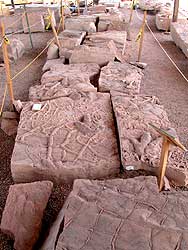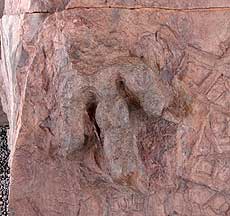Dinosaur Facts | Fossil Formation | Geologic Time | Glossary
Johnson Farm Dinosaur Tracks
The greatest dinosaur track discovery took place February 2000 on the outskirts of the small city of St. George, Utah. Dr. Sheldon Johnson, a retired optometrist, was in the process of leveling a sandy hill on his property when he discovered a number of large rectangular sandstone blocks. While moving one of the rocks he found bumps on the underside. Under closer inspection Dr. Johnson discovered that they were perfect dinosaur track casts. He turned over another rock and another, and his excitement grew as he discovered track after track. Dr. Johnson wondered who would be interested in this find and who would be willing to come out and inspect the tracks he had uncovered. Dr. Johnson contacted paleontologist experts and was told this was the largest set of dinosaur tracks ever found. Within a short time the dinosaur tracks became the most popular attraction in St. George.
 The tracks were made from about 200 to 205 million years ago during the early Jurassic
period. At this time southern Utah and Arizona were much nearer to the equator and
were close to sea level. There were numerous streams and lakes throughout the area.
It was a perfect habitat for the carnivorous Eubrontes dinosaurs such as the
Dilophosaurus.
The Dilophosaurus was the largest dinosaur of the early Jurassic period
measuring 19 feet long and 6 1/2 feet tall. It had crests on each side of its head. It
stood on two legs with three-toe clawed feet measuring 13 to 18 inches long. From
the back of the foot protruded a dew claw or hallux. A fully grown Dilophosaurus
weighed around 900 pounds.
The tracks were made from about 200 to 205 million years ago during the early Jurassic
period. At this time southern Utah and Arizona were much nearer to the equator and
were close to sea level. There were numerous streams and lakes throughout the area.
It was a perfect habitat for the carnivorous Eubrontes dinosaurs such as the
Dilophosaurus.
The Dilophosaurus was the largest dinosaur of the early Jurassic period
measuring 19 feet long and 6 1/2 feet tall. It had crests on each side of its head. It
stood on two legs with three-toe clawed feet measuring 13 to 18 inches long. From
the back of the foot protruded a dew claw or hallux. A fully grown Dilophosaurus
weighed around 900 pounds.
Smaller 4 to 8 inch tracks were made by the ichnogenus Grallator such as the slender meat eating Megapnosaurus. Additional small one-inch Batrachopus dinosaur tracks of an early crocodilian have been found. Other unique features include swimming tracks, tail drags and rippled surfaces. A number of fossils have been identified in the area including those of fish, water lilies, stromatolites, ostracods, conchostracans, and conifer branches with needles still attached.
How were the tracks formed
The Johnson farms dinosaur tracks lie within the Moenave formation which includes layers of sandstone, mudstone, and shale. The tracks were found at the bottom of a three-foot thick layer of sandstone overlaying mudstone. The fossil evidence indicates that the Johnson farm was located along the margins of a shallow saline lake 200 million years ago. As the water receded, dinosaurs walking through the leftover clay left impressions of their feet including scales of their skin and prints of their toes. As the mud hardened, cracks around the tracks formed. Eventually the lake level rose and buried the tracks with sand and silt. Over time the sand hardened and became sandstone thus preserving the dinosaur tracks. Within the three-foot sandstone blocks are several track-forming layers.
Enjoy exploring the galleries of Johnson farm dinosaur tracks including the 3D photo gallery.
